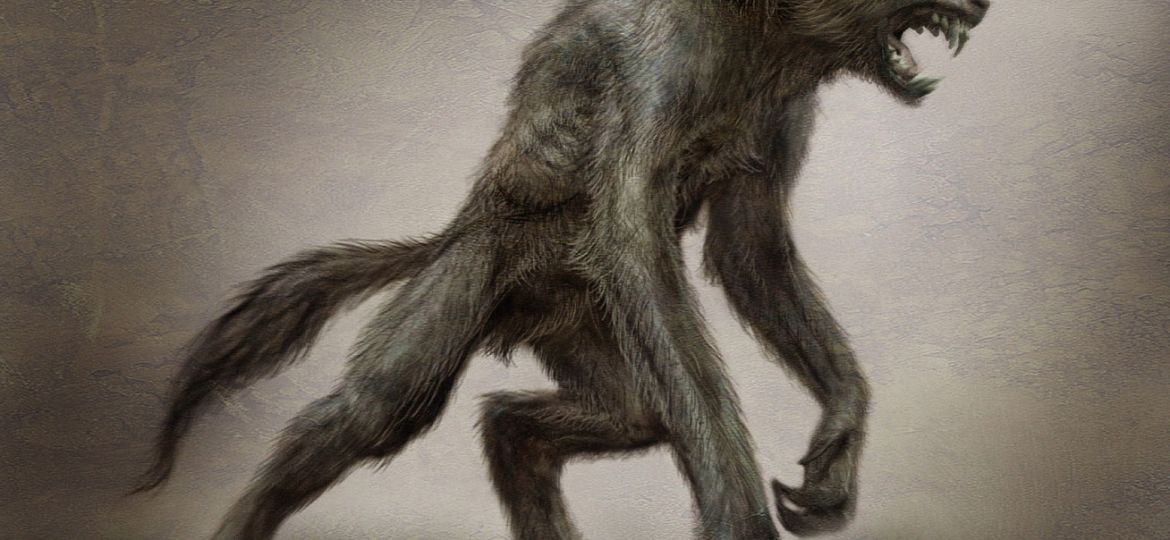
Continuing to ride the wave of classic monsters still popular in the public consciousness, today we turn our attention to the lycanthropes or as they’re more commonly called, werewolves.
The word is derived from Old English, with “were” meaning an adult man and “wolf” meaning…um, wolf. Myths and folk tales about werewolves became common in Europe during the Middle Ages, yet these stories harkened back to old initiation rites of warriors during the Iron Age. In the times of pagan Germany, there was class known as the Tierkrieger (“animal warriors”) who would don the pelts of the beasts they’d hunted, and as Christianity spread and took root throughout Europe, rumors of savage wolf-men roaming the forests began to circulate, and since these wolf-men were pagan, they were, of course, associated with the devil.

How people became werewolves was never something that was really consistent since their whole existence was based upon superstition and gossip via word of mouth. The transformation could be either permanent or temporary. Sometimes the person becomes a werewolf by removing one’s clothes and putting on wolf skin in its stead. Other explanations claimed that rubbing oneself with a magic salve or drinking water from the footprint of the animal would lead to a transformation. (Right…because that explains a lot.) However, the most popular claim was that if anyone had been bitten by one, he or she would become one as well.

Regardless of how one becomes a werewolf, the common belief is that while one is transformed, that person is not the same person he or she normally would be. The person under the spell enters a sort of trance and gets lost in the mire of the base and puerile instincts of a wild beast.
Many of the traits of lycanthropy are rooted with symbols of Western values. For the sake of brevity, we’ll examine two.
The first is the transformation taking place every full moon. Why is that? Many societies that operated on a lunar calendar held celebrations on full moon nights since the amount of light reflected by the moon made it easier for people to enjoy the party. Not surprisingly, many people would behave stupidly and even completely reckless to the point of danger that a belief developed that the full moon made some people become insane. (Hence why they were called lunatics.) Over time, that also became associated with the lycan condition due to the savagery of its nature. This also explains why werewolves began to be associated with the devil besides the old pagan practices; the behavior of werewolf is seen as sinful by Christianity, and despite the person no longer having control while transformed, the person is still cursed from within and has tainted his or her soul.
The second is the use of silver to kill a werewolf. According to the 1941 film, The Wolf Man starring Lon Chaney, Jr., a werewolf can only be killed a silver bullet, a silver blade or a stick with a silver handle. Again, this also relates to Christianity. In the Gospel of Matthew, Judas Iscariot betrayed Jesus Christ for 30 pieces of silver, and because of that, silver became a weapon which Christians could wield against those seen as enemies of Christ.

However, the use of silver also has scientific evidence for its effectiveness. Besides the sheer trauma and possible shrapnel from the attack, silver can cause chemical death. While it isn’t poisonous in its pure form, the salts formed by it are highly toxic, and if silver cations were to bond with the right anions in the bloodstream of a living creature, it would most certainly cause the victim to die.
While werewolves don’t seem to have a strong presence in the public eye on their own, they garner most attention when paired with vampires (the Twilight series, the Underworld series, True Blood, Van Helsing, etc.), and this works because they make great adversaries. While vampires might look human but have lost their connection to humanity, werewolves still have their humanity buried deep behind the exterior rage that looms forth every full moon.
And perhaps that’s why we love werewolves. They remind us that as civilized as we think we are, underneath it all we’re still nothing more than animals, and it’s only when we lose ourselves to lycanthropy that the true animal of our nature comes out in us. Like zombies, anyone can be one, but the saving grace of the wolfbane is that our time as a wolf is only temporary, and if we can slay the beast that changed us into monsters, we can overcome the curse and rescue our better nature.







werewolves are very rarely done well, but when they are, we end up getting true horror classics. dog soldiers. silver bullet. undeworld. the vampire diaries. every now and then we get some awesome versions. can’t wait to read the next shocktoberfest article!
I know the full moon transformations are practically canon, now, but I’d like for them to use the Peter Stumpp method more.
Stumpp, tried and executed for horrible crimes while being a werewolf, claimed The Devil gave him a belt that transformed him into a werewolf. Why, that’s practically Superhero origin story.